Did you know that over 30% of home gardeners lose crops to pests yearly? If you’re tired of bugs munching on your plants, let’s whip up some natural repellents. Start with a simple garlic spray by blending two crushed cloves with a cup of water, then straining it. I’ve got more tricks up my sleeve, so stick around for easy, effective recipes to safeguard your garden!
Contents
Garlic Spray Recipe
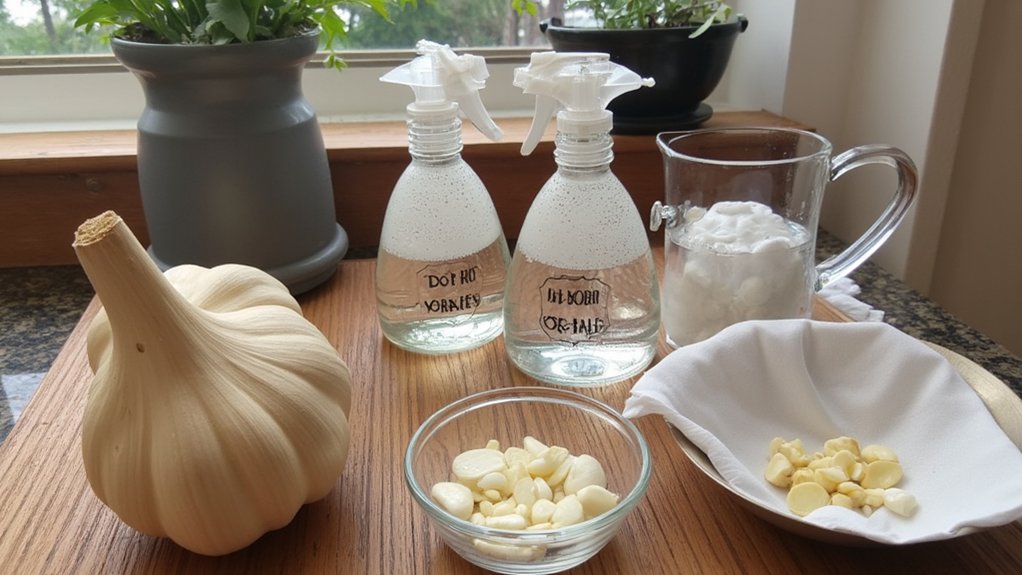
Hey, let’s kick off with a super simple garlic spray recipe to keep pests off your plants. You’ve got this, and it’s cheap! Grab 2 whole garlic bulbs, peel ‘em, and crush the cloves.
Now, toss those crushed cloves into a blender with 2 cups of water. Blend until it’s a smooth, stinky mix, then strain it through a cheesecloth into a jar. You don’t want chunks clogging your sprayer, right?
Next, pour that liquid into a spray bottle, add a teaspoon of dish soap, and shake it up. Spray it on your plants every 5-7 days, especially after rain. Cover leaves top to bottom, focusing on pest hotspots. Store leftovers in the fridge for up to a week. Easy, huh?
Neem Oil Solution
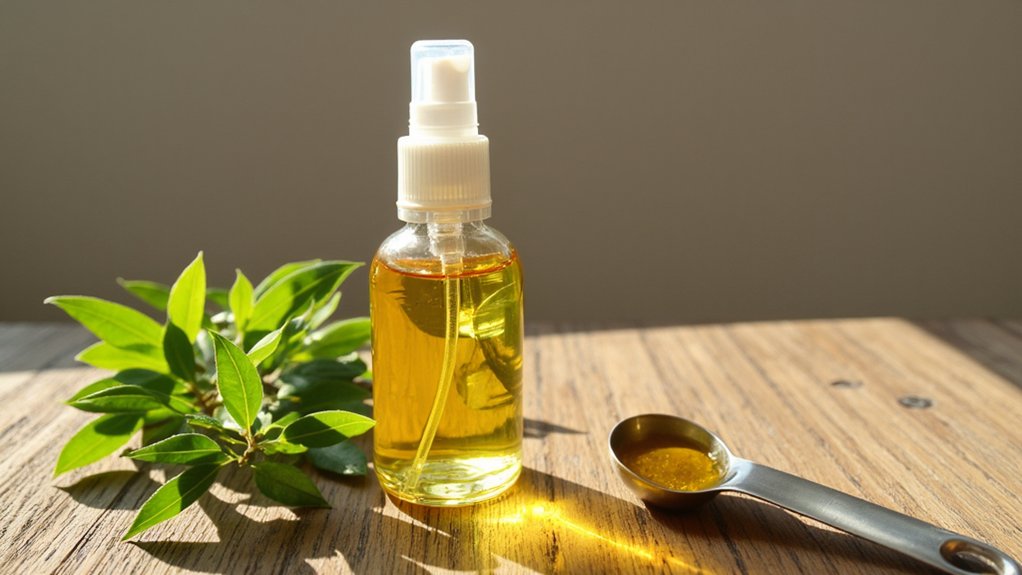
Ready for another powerful pest repellent? Let’s explore making a Neem Oil Solution, a fantastic way to shield your plants. Neem oil, derived from the neem tree, messes with pests’ life cycles, stopping them from feeding.
Here’s how you whip it up. Mix 2 teaspoons of pure neem oil with 1 teaspoon of mild liquid soap in a quart of water. Shake it well in a spray bottle to blend everything properly.
Now, apply it directly to your plants, especially under the leaves where bugs hide. Spray every 7-14 days, ideally in the early morning or late evening, to avoid harming beneficial insects. Test a small area first, though, as some plants might react badly to it. Keep at it, and watch those pests disappear!
Peppermint Oil Mixture
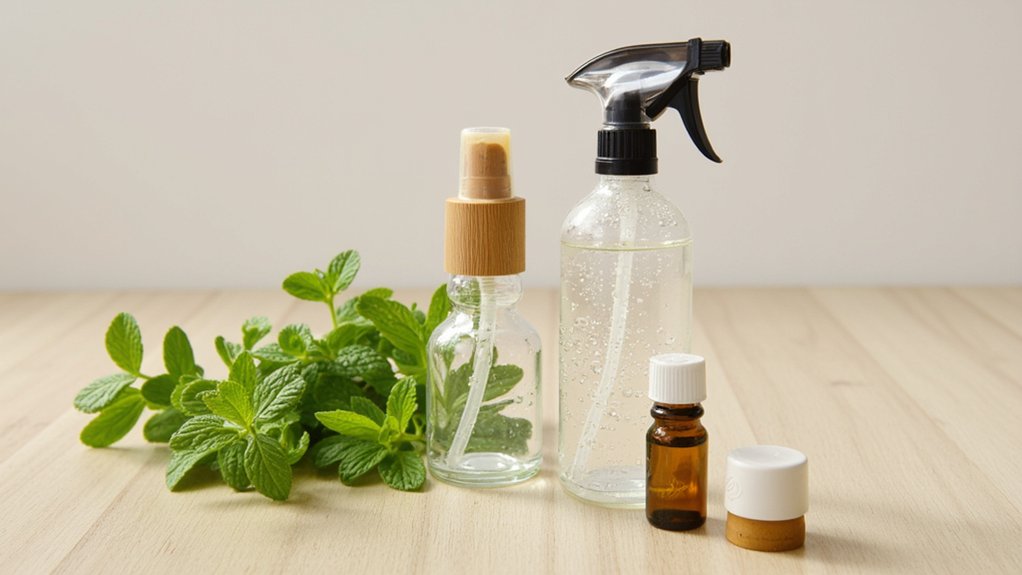
Curious about another natural pest repellent? Let’s explore making a peppermint oil mixture, a simple yet effective solution. You’ll need 10 drops of pure peppermint essential oil, a quart of water, and a spray bottle.
Start by filling the spray bottle with the water, then add the peppermint oil drops. Shake it well to mix; this guarantees the oil disperses evenly. You’re targeting pests like ants, aphids, and spiders with this strong, minty scent they hate.
Apply it by spraying directly on your plant leaves, especially under them, every 3-4 days. Focus on areas where pests gather, but avoid over-spraying to prevent leaf damage. Store the bottle in a cool, dark place. It’s that easy to keep bugs at bay!
Chili Pepper Infusion

Looking for another way to shield your plants from pests after trying peppermint oil? Well, let’s whip up a chili pepper infusion. This fiery mix can deter bugs with its spicy kick.
Grab 2 tablespoons of dried chili flakes or 5 fresh hot peppers, finely chopped. Add them to 1 quart of water in a pot, then heat it to a simmer for 15 minutes. Let it cool completely, strain out the solids, and pour the liquid into a spray bottle.
Now, test it on a small leaf first, just to be safe. If all’s good, spray it lightly on your plants every 3-4 days, especially after rain. Keep it away from your eyes, though—that sting’s no joke!
Vinegar-Based Repellent
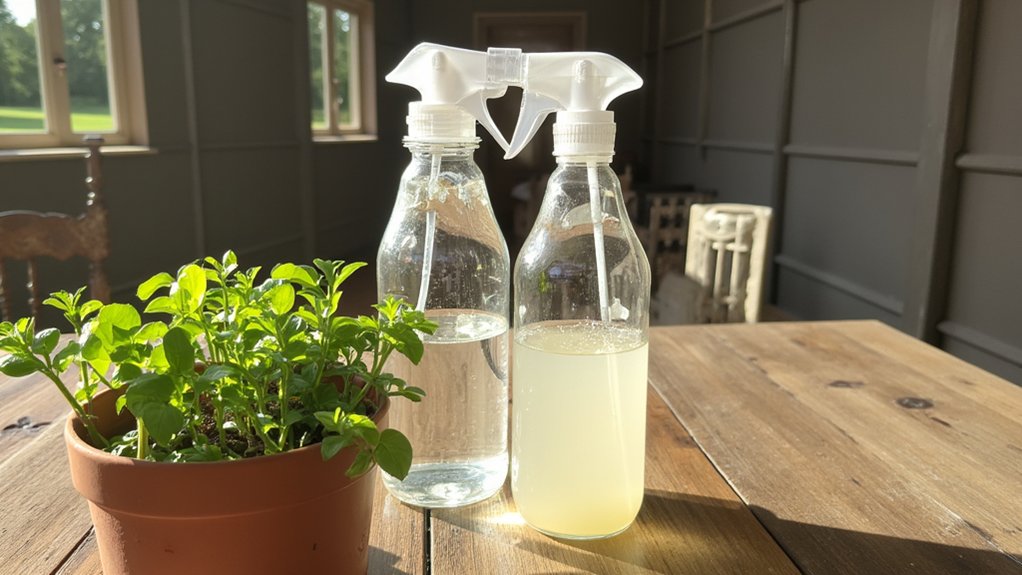
Another solid option to protect your plants from pests is a vinegar-based repellent. You’ve probably got vinegar in your kitchen, so let’s put it to work. This simple mix can deter bugs like aphids and ants without harsh chemicals.
Start by combining one part white vinegar with three parts water in a spray bottle. Shake it well, ensuring it’s mixed thoroughly, before you apply it. Spray this solution directly onto your plant leaves, focusing on areas where pests gather, but avoid drenching the soil.
Reapply every few days, especially after rain, to keep the barrier strong. Test it on a small leaf first, though, since some plants might react poorly. If you see wilting, dilute it more and try again.
Lavender Essential Oil
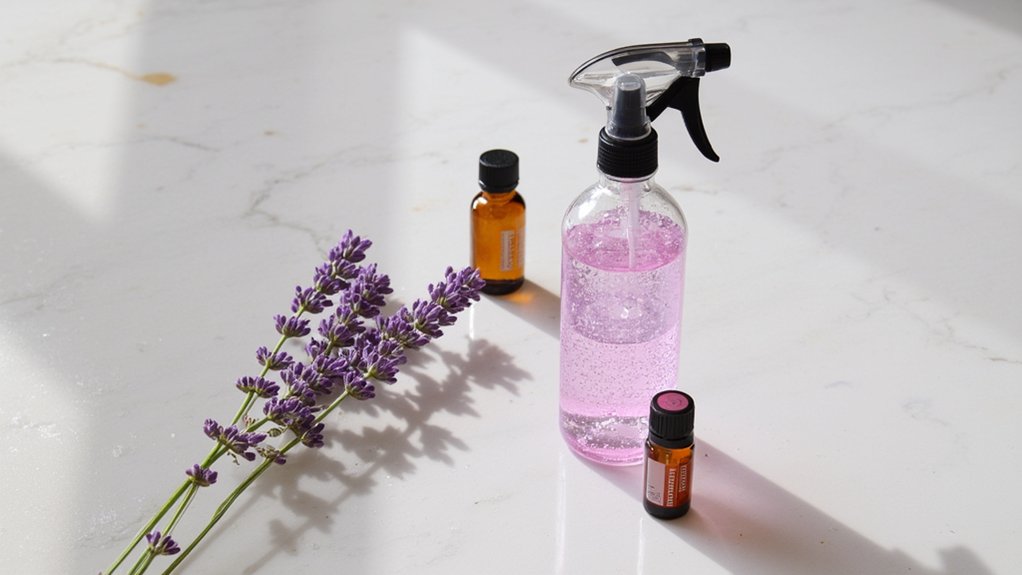
Let’s switch gears and talk about using lavender essential oil as a natural pest repellent for your plants. It’s a simple, effective option. Many pests, like aphids and moths, hate its strong scent, so you’ve got a winner here.
Start by grabbing a small spray bottle, about 8 ounces in size. Add 10-15 drops of pure lavender essential oil, then fill the rest with water. Shake it well to mix, and you’re ready to go.
Spray this mixture lightly on your plant leaves every 3-4 days, especially in the early morning. Focus on areas where pests gather, like under leaves. Don’t drench the plants, though; a fine mist works best. Keep an eye out, and reapply if pests return.
Rosemary Infusion Repellent
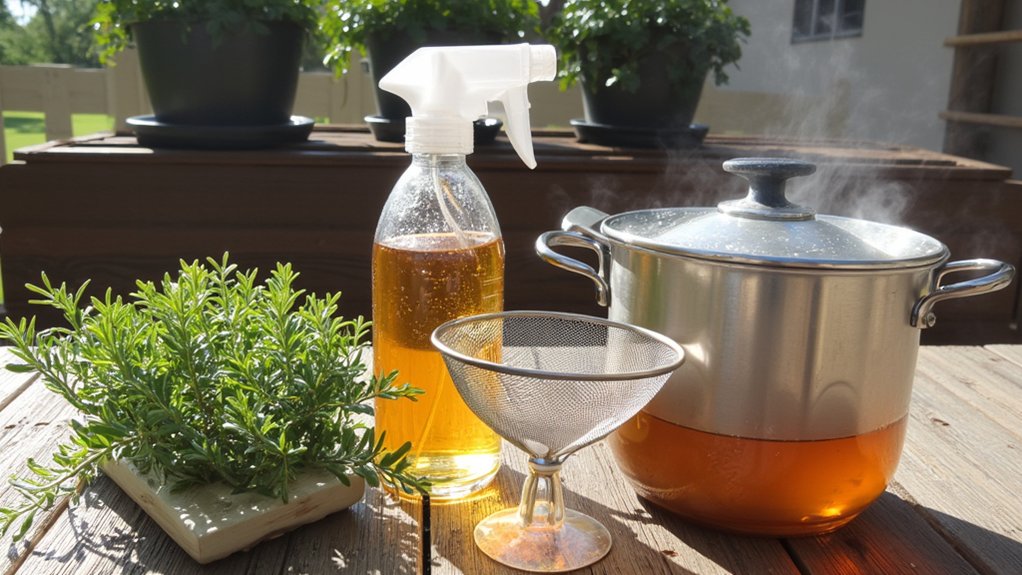
Rosemary infusion repellent offers a fantastic, natural way to keep pests off your plants. You’ve likely got rosemary in your kitchen, so let’s put it to work! This method is simple, effective, and safe for most gardens.
Start by boiling 2 cups of water, then add 4 tablespoons of fresh rosemary leaves. Let it steep for 30 minutes, covered, to extract the oils. Strain the liquid into a spray bottle, and you’re ready to go.
Apply this infusion directly to your plants’ leaves, focusing on areas where pests linger. Repeat every 3-4 days, especially after rain, to maintain protection. Store any leftover mix in the fridge for up to a week. It’s an easy fix for pesky bugs!
Cinnamon Powder Deterrent
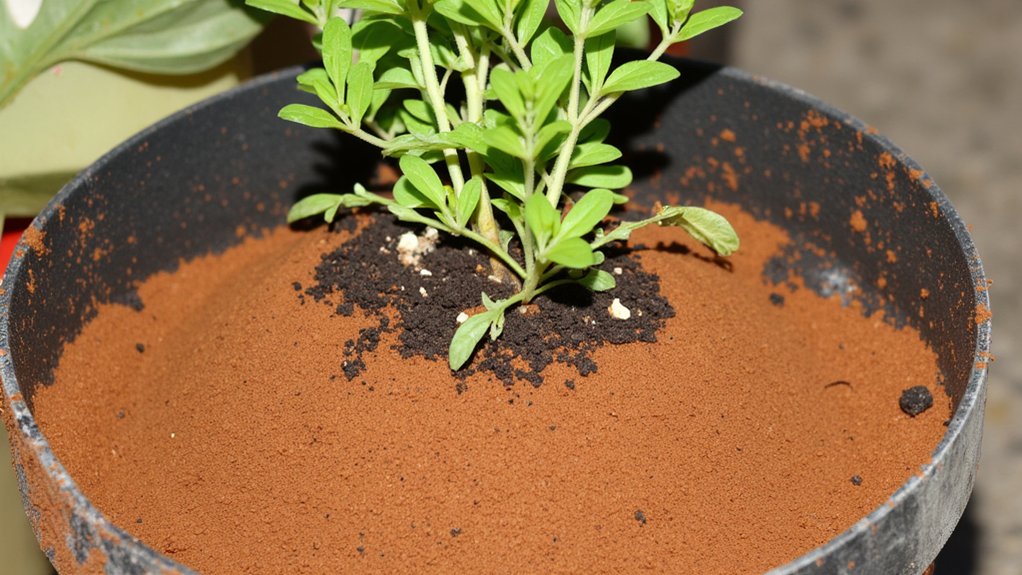
While exploring natural pest solutions, you’ll find cinnamon powder to be a surprisingly effective deterrent. It’s cheap, easy to use, and right in your kitchen! Many pests, like ants and fungi, can’t stand its strong scent.
Start by grabbing a small container of ground cinnamon, about 2 tablespoons should do. Sprinkle it lightly around the base of your plants, focusing on areas where you’ve noticed pest activity. Don’t overdo it; a thin layer, roughly 1/8 inch thick, works best.
Reapply every 7-10 days, especially after rain, as it can wash away. You’ll see fewer creepy crawlies in no time with this trick. Just keep an eye on your plants to make sure they’re not reacting poorly to the powder.
Turmeric Root Spray

As you immerse yourself in natural pest control, consider making a turmeric root spray for your plants. It’s a simple, effective way to keep bugs at bay. Turmeric’s natural compounds, like curcumin, repel many common pests.
Start by grating 2 tablespoons of fresh turmeric root, or use 1 tablespoon of powdered turmeric if that’s easier. Mix it with 1 quart of water in a pot, then simmer for 10 minutes. Let it cool completely, strain if needed, and pour into a spray bottle.
Apply this spray to your plants’ leaves every 3-4 days, especially after rain. Focus on the undersides where pests hide. You’ll notice fewer critters munching away. Just remember, reapply consistently for the best results, and store leftovers in the fridge.
Basil Leaf Extract
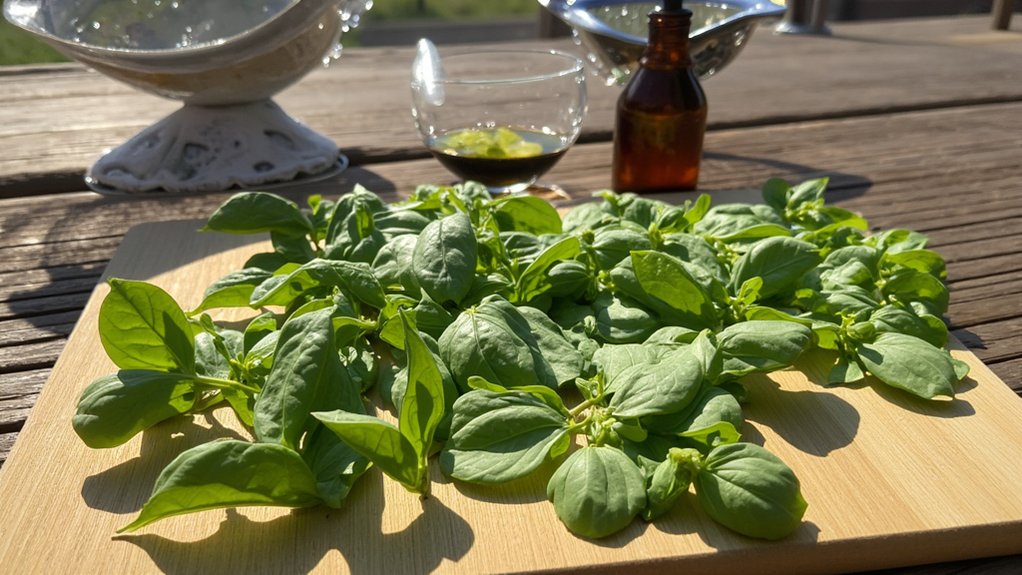
Hey, let’s switch gears from turmeric and talk about basil leaf extract for pest control. You’ve probably got basil in your kitchen, right? Well, it’s not just for pasta; it repels pests like aphids and mosquitoes.
Here’s how you make it. Grab about 1 cup of fresh basil leaves, chop them roughly, and toss them into a bowl. Pour 2 cups of boiling water over them, then let it steep for 4 hours. After that, strain the liquid into a spray bottle, and you’re set to go.
Apply this extract directly to your plant leaves every 3 days. Focus on the undersides, where pests hide most. It’s a simple, effective trick to keep bugs at bay without chemicals.
